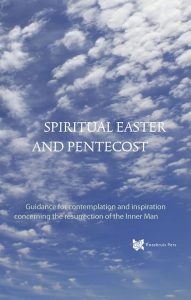REFLECTION SUNDAY BEFORE EASTER: THE PASSAGE
During the next eight days we will undertake an exploration of the inner processes related to the esoteric meaning of Easter. The narratives on which we base this come from The Gospel of the Holy Twelve by Gideon Jasper Ouseley.
During sleep, our ‘night consciousness’ can lift itself into the domain of the soul, the invisible realm of the primordial ideas from which the sacred scriptures of humanity originate.
We therefore recommend that at night before sleeping you read the indicated text from The Gospel of the Holy Twelve and open your consciousness to its inner value. The hours of sleep thus become a good preparation for the reflection that you can read or listen to in the morning. On the basis of the narratives, the reflections illuminate the essence of the gnostic path for which humanity is now ripe.
The inner Christianity of the ‘kingdom of the soul’ is announced and described by, among others, Rudolf Steiner, Max Heindel, Jan van Rijckenborgh and Catharose de Petri. They walked that inner path and propagated the elevated reality of it in their writings. The reflections of this online module are inspired mainly by their writings.
The mystery of Easter indicates a spiritual event that can take place within the human being: the resurrection of the inner man. The road to the Resurrection, also called ‘the Path’, is a process of transformation. The narratives and reflections of this online module may contribute to deepening the understanding of the Path.
The subject of the ‘inner man’ confronts us immediately with our duality; a state of being which can be experienced quite intensely. Because on the one hand we are the outer person with our own character, our pleasures and our habits, but on the other hand we are also the Other-One-within-us, the inner being who longs for a higher and purer life.
The feast of Easter is closely related to the Pesach, the Jewish Passover celebration which commemorates the exodus from slavery in Egypt through the desert to the promised land. The Christian Easter is the commemoration of the resurrection of Jesus Christ after his crucifixion and is celebrated on the first Sunday after the first full moon in spring. The original concept of ‘Passover’ means ‘to pass over the threshold.’
A human being setting out to cross the threshold to celebrate his inner Passover, is becoming increasingly aware of the fact that he is participating in two completely different worlds: the spatiotemporal world and the world of the soul.
In a symbolic and universal sense both the Jewish and the Christian Passover (Easter) refer to processes of renewal, transformation and inner liberation.
For the arrival in the promised land and the realisation of the resurrection both indicate a higher destiny that the inner man can reach: to once more regain part of his original pure life.
Living through these processes is referred to as a ‘journey’, as a departure or exodus from the bondage of material existence, through which in the mortal man something immortal develops: the inner man. The most important symbol of the Passover, the egg, is among other things a universal symbol for rebirth.
The inner Easter celebration has for many centuries been compared with the metamorphosis from caterpillar to butterfly. The caterpillar withdraws at a specific time and spins itself into a cocoon, into something that resembles an egg. Seemingly nothing happens at all. But in reality, all the material of which the caterpillar consists is being transformed into a totally new being.
The caterpillar does not change but is completely dissolved and rebuilt again into a totally new creature inside the cocoon. And from the cocoon arises a colourful butterfly that is no longer bound to the earth, but can soar in a completely new domain of life: the air.
According to inner Christianity, also known as esoteric Christianity or Gnostic Christianity, each human being is called to realise the higher life in himself and by means of himself, through transformation and transfiguration.
For although our human physical body is a very special and specialised organism with latent spiritual faculties, until now it is still fully attuned to life in the material world. However, it has far greater capabilities. It has been called into being for a specific purpose which is: to be fertile soil in which the resurrection-body can germinate and grow.
The resurrection body is the immaterial vehicle through which the Other-One-within-us can express itself in its own domain, the non-material ‘kingdom of the soul.’ In our material world, the soul cannot breathe and is therein as ‘nearly dead’. But the voice of the soul resounds in us as a desire for unity, freedom and love.
The universal symbolism of the egg expresses the universal knowledge of the ‘transformation into immortal life’, of crossing the threshold. The annual Easter celebration is thus an outer form of a universal spiritual process that is not linked to a person or time, but can take place in each human being.
The way in which this process is described in Christianity, amongst other texts in the four Gospels of the New Testament, is specifically applicable to the period in which we now live. For most people, the story of the life of Jesus is an historical or mythical story and for others it has even no value any more.
But the basic pattern of the Gospels stems from the realm of the soul, and with the right keys it reveals itself through highly accurate descriptions of the process of constructing the resurrection body.
The story of Jesus is the story of the earthly life that begins with the birth in Bethlehem and ends with the death on Golgotha. After a threefold process, symbolised by three days, the resurrection in a new, radiant body follows.
The solar spirit which incarnated on earth around the beginning of our era in the mortal man Jesus had the task, as the first entity, to accomplish the entire process of building the resurrection body within a mortal body. Only in this way could a completely new path of liberation be opened for humanity, namely the possibility for any mortal man to build a soul body, in direct bonding with the Christ-power, without depending on priests or masters.
The human being who enters the Christian gnostic path is therefore in a spiritual sense a follower of Jesus, someone who undertakes within himself the journey from Bethlehem to Golgotha.
A deep desire for a true human life and recognition of one’s own duality are conditions for searching for ‘new life’. Only on this basis of deep longing can the willingness to go the path be brought about.
The preparation for going the path is intense and takes place in our daily lives, even if we are not aware of it. The spiritual path actually begins with a reversal which is symbolised by the baptism in water: the consciously chosen initial connection with the liberating power. For it is only by making a conscious choice for the inner life that the path can be entered.
Through baptism by water Jesus, the inner man, becomes connected with a high spiritual power, the Christ power. From that moment on he is Jesus the Christ.
Immediately after the baptism by water every pupil of the soul is being placed before the obstructive tendencies of mortal man: possessiveness, lust for power and ambition. This struggle, which is an inevitable stage on the path, is reflected in the story of the temptations in the desert.
After the victory over these forces the process continues. Jesus, the new inner force, travels around, selects disciples and on the top of a mountain pronounces the so-called Sermon on the Mount, in which he passes on directions for a higher spiritual life to our consciousness. Jesus teaches, tells parables and heals the sick. Finally, he travels to Jerusalem, where initially he is received with cheers.
Then follow the cleansing of the temple, the Last Supper, the arrest in the Garden of Gethsemane, the trial, the crucifixion, the burial and finally the resurrection.
A very special aspect is the betrayal by Judas Iscariot, the betrayal that had to take place in order to make the purpose of the journey, the resurrection, possible.
The week from Palm Sunday to Easter is known in the Christian tradition as the silent week, the Holy Week and the Good Week. The next eight days provide an opportunity to delve into the esoteric meaning of these narratives, which are revelations of the Christian initiation mystery. Jesus spoke about this process in parables to the multitudes, but openly to his disciples. In The Gospel of the Holy Twelve we read about this:
And the disciples came and said to him, Why do you speak to the multitude in parables?” He replied: “Because it is given to you to know the mysteries of the
kingdom of Heaven, but to them it is not given.
Therefore, I speak to them in parables because they, seeing, do not see, and hearing, they do not hear, neither do they understand. But blessed are your eyes, for they see, and your ears, for they hear, and your hearts, for they understand.
The Gospel of the Holy Twelve 40: 1, 3, 5
We wish you a good week.

